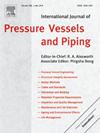9% Cr铁素体-马氏体钢在超临界水中的氧化:Co和Cu的作用
IF 3
2区 工程技术
Q2 ENGINEERING, MECHANICAL
International Journal of Pressure Vessels and Piping
Pub Date : 2025-04-29
DOI:10.1016/j.ijpvp.2025.105540
引用次数: 0
摘要
比较了P92 (Cr-Mo-V钢)和G115(含Co和Cu改性钢)在650℃、30 MPa的脱氧超临界水中的氧化行为。合金元素(Co和Cu)及其显微组织特征显著提高了G115钢的抗氧化性能。在氧化初期(0 ~ 156 h),抗氧化Co扩散到G115的残余基体中,部分阻碍了内氧化层的完全氧化,导致G115的内氧化层较P92厚。同时,富cu颗粒在氧化物/残余基体界面的内部氧化层内析出。在氧化中期(215 h), G115中富集co的残余基体层和高角度晶界有利于形成连续致密的富cr氧化层。而P92则形成不连续的富cr层。G115中致密的富cr氧化层通过阻碍离子扩散有效地降低了腐蚀速率。在长时间氧化阶段(800 h),富cr氧化层下受阻的Fe扩散增加了局部氧活性,加速了Fe3O4向Fe2O3的转变。同时,Cu在上层富cr氧化层下迁移,形成富Cu保护亚层。本文章由计算机程序翻译,如有差异,请以英文原文为准。
Oxidation of 9 % Cr ferritic-martensitic steels in supercritical water: role of Co and Cu addition
The oxidation behavior of P92 (Cr-Mo-V steel) and G115 (modified steel containing Co and Cu) were compared in deoxygenated supercritical water (SCW) at 650 °C and 30 MPa. The oxidation resistance of G115 steel was significantly enhanced by alloying elements (Co and Cu) and its microstructural characteristics. In the early oxidation stage (0–156 h) of oxidation, oxidation-resistant Co diffused into the residual matrix of G115, partially hindering the complete oxidation of the internal oxide layer, resulting in a thicker internal oxide layer compared to P92. Simultaneously, Cu-rich particles precipitated within the internal oxide layer at the interface between oxide/residual matrix. By the mid-term oxidation stage (215 h), the Co-enriched residual matrix layer and high-angle grain boundaries in G115 facilitated the formation of a continuous, dense Cr-rich oxide layer. In contrast, P92 developed a discontinuous Cr-rich layer. The dense Cr-rich oxide layer in G115 effectively reduced corrosion rates by hindering ion diffusion. In the long-term oxidation stage (800 h), hindered Fe diffusion beneath the Cr-rich oxide layer increased the local oxygen activity, accelerating the transformation of Fe3O4 to Fe2O3. Meanwhile, Cu migrated beneath the upper Cr-rich oxide layer, forming a protective Cu-rich sublayer.
求助全文
通过发布文献求助,成功后即可免费获取论文全文。
去求助
来源期刊
CiteScore
5.30
自引率
13.30%
发文量
208
审稿时长
17 months
期刊介绍:
Pressure vessel engineering technology is of importance in many branches of industry. This journal publishes the latest research results and related information on all its associated aspects, with particular emphasis on the structural integrity assessment, maintenance and life extension of pressurised process engineering plants.
The anticipated coverage of the International Journal of Pressure Vessels and Piping ranges from simple mass-produced pressure vessels to large custom-built vessels and tanks. Pressure vessels technology is a developing field, and contributions on the following topics will therefore be welcome:
• Pressure vessel engineering
• Structural integrity assessment
• Design methods
• Codes and standards
• Fabrication and welding
• Materials properties requirements
• Inspection and quality management
• Maintenance and life extension
• Ageing and environmental effects
• Life management
Of particular importance are papers covering aspects of significant practical application which could lead to major improvements in economy, reliability and useful life. While most accepted papers represent the results of original applied research, critical reviews of topical interest by world-leading experts will also appear from time to time.
International Journal of Pressure Vessels and Piping is indispensable reading for engineering professionals involved in the energy, petrochemicals, process plant, transport, aerospace and related industries; for manufacturers of pressure vessels and ancillary equipment; and for academics pursuing research in these areas.

 求助内容:
求助内容: 应助结果提醒方式:
应助结果提醒方式:


